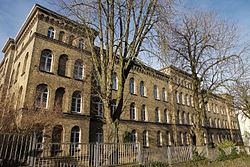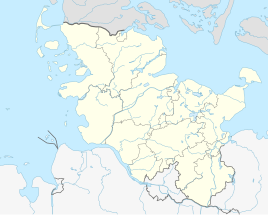Junkerhohlweg barracks
| Junkerhohlweg barracks | |||
|---|---|---|---|

Junkerhohlweg barracks (2012) |
|||
| country | Germany | ||
| today | Residential buildings | ||
| local community | Flensburg | ||
| Coordinates : | 54 ° 48 ' N , 9 ° 25' E | ||
| Opened | 1893-1897 | ||
| owner | Hanse-Agrar Handelsgesellschaft mbh | ||
| Formerly stationed units | |||
| Fusilier Regiment No. 86 |
|
||
|
Location of the Junkerhohlweg barracks in Schleswig-Holstein |
|||
The Junkerhohlweg barracks is a former barracks in the Duburg district of Flensburg . It is one of the cultural monuments of the Neustadt district .
history
The barracks were built between 1893 and 1897 as the so-called "urban barracks". The barracks was given the address of Junker defile 17. The eponymous today street name of the barracks, which is attested for the first time since 1823, possibly related to a Junker , who in the Middle Ages there at the ravine , lived, leading to Duburgareal. (see Eddeboe on Junkerplatz , Hof Flenstoft and Duburg ). The architect of the three-storey yellow brick building in the historicism style was the town planning officer Otto Fielitz , who was also responsible for the planning of the neighboring monastery building , the Anna-Thomsen-Stift and probably also the Nackestift . The barracks served as an expansion site for the Fusilier Regiment "Queen" No. 86 , which was also stationed in the neighboring Duburg barracks .
Furthermore, a chamber building was built for the Junkerhohlweg barracks, which was used for storage purposes . The aforementioned armory at Harrisleer Strasse 9 a – b was built as a solitary building and therefore found its place northwest of the barracks, free-standing in the area ( location ).
The Flensburg football club FFC , newly formed in 1908, played in its early days at the barracks courtyard at Junkerhohlweg barracks. In 1935 the neighboring tank barracks were built . After the Second World War , the Junkerhohlweg barracks served as a refugee camp for around 181 people until the mid-1950s. In the following Cold War period , it was used by the Bundeswehr . The barracks were abandoned around 1994.
In 1996/97 the barracks were converted for residential purposes. The neighboring Duburg barracks was previously demolished in 1989/1990. This made the Junkerhohlweg barracks the last unaltered barracks building in the city, reminiscent of the Prussian era in the 19th century. At the Flensburg-Mürwik base, there are still the Tirpitz and Maaß barracks from the Prussian era, which were built in 1901/1902, but have changed significantly in terms of their structure. The Junkerhohlweg barracks, which was converted into a residential complex, has been owned by Hanse-Agrar GmbH since 2006 .
From 2006 to 2009 the preserved, listed chamber building of the Junkerhohlweg barracks was also restored. The ABC-Autoteile company is located in the building today.
After abandoning the neighboring armored barracks of the Bundeswehr in 2015, a new building and redevelopment area is planned for 2017 in the vicinity of the two barracks.
Individual evidence
- ↑ a b c d e Lutz Wilde : Monument topography Federal Republic of Germany, cultural monuments in Schleswig-Holstein . Volume 2, Flensburg, page 334
- ^ Lutz Wilde : Monument topography Federal Republic of Germany, cultural monuments in Schleswig-Holstein . Volume 2, Flensburg, page 332
- ↑ Flensburg street names . Society for Flensburg City History, Flensburg 2005, ISBN 3-925856-50-1 , article: Junkerhohlweg
- ↑ See Andreas Oeding, Broder Schwensen, Michael Sturm: Flexikon. 725 aha experiences from Flensburg! . Flensburg 2009, article: Duburg barracks
- ^ Zeughaus Harrisleer Strasse 9a and 9b , accessed on: February 1, 2017
- ↑ The building was probably interpreted as an old riding stable due to misunderstandings. see. Exhibition. Art Dialog Neustadt , from: April 2006; accessed on: February 1, 2017
- ^ Zeughaus Harrisleer Strasse 9a and 9b , accessed on: February 1, 2017
- ↑ 08 story. July 21, 2014, accessed January 10, 2016 .
- ↑ a b Flensburger Tageblatt : Schwarzenbachtal in Flensburg: A new quarter for the Neustadt , from: December 11, 2015; Retrieved on: January 10, 2016
- ↑ Gerhard Paul u. Broder Schwensen (Ed.): May '45. End of the war in Flensburg , Flensburg 2015, pp. 162 and 176
- ^ Andreas Oeding, Broder Schwensen, Michael Sturm: Flexikon. 725 aha experiences from Flensburg! . Flensburg 2009, article: Duburg barracks
- ↑ The history of the Anna-Thomsen-Stift , accessed on: January 10, 2016
- ↑ Hanse-Agrar Handelsgesellschaft mbh - The residential complex , accessed on: January 10, 2016
- ^ Zeughaus Harrisleer Strasse 9a and 9b , accessed on: February 1, 2017
- ↑ Flensburger Tageblatt Automobile Sicherheit am Traditional Location , dated: January 30, 2009; accessed on: January 1, 2017
